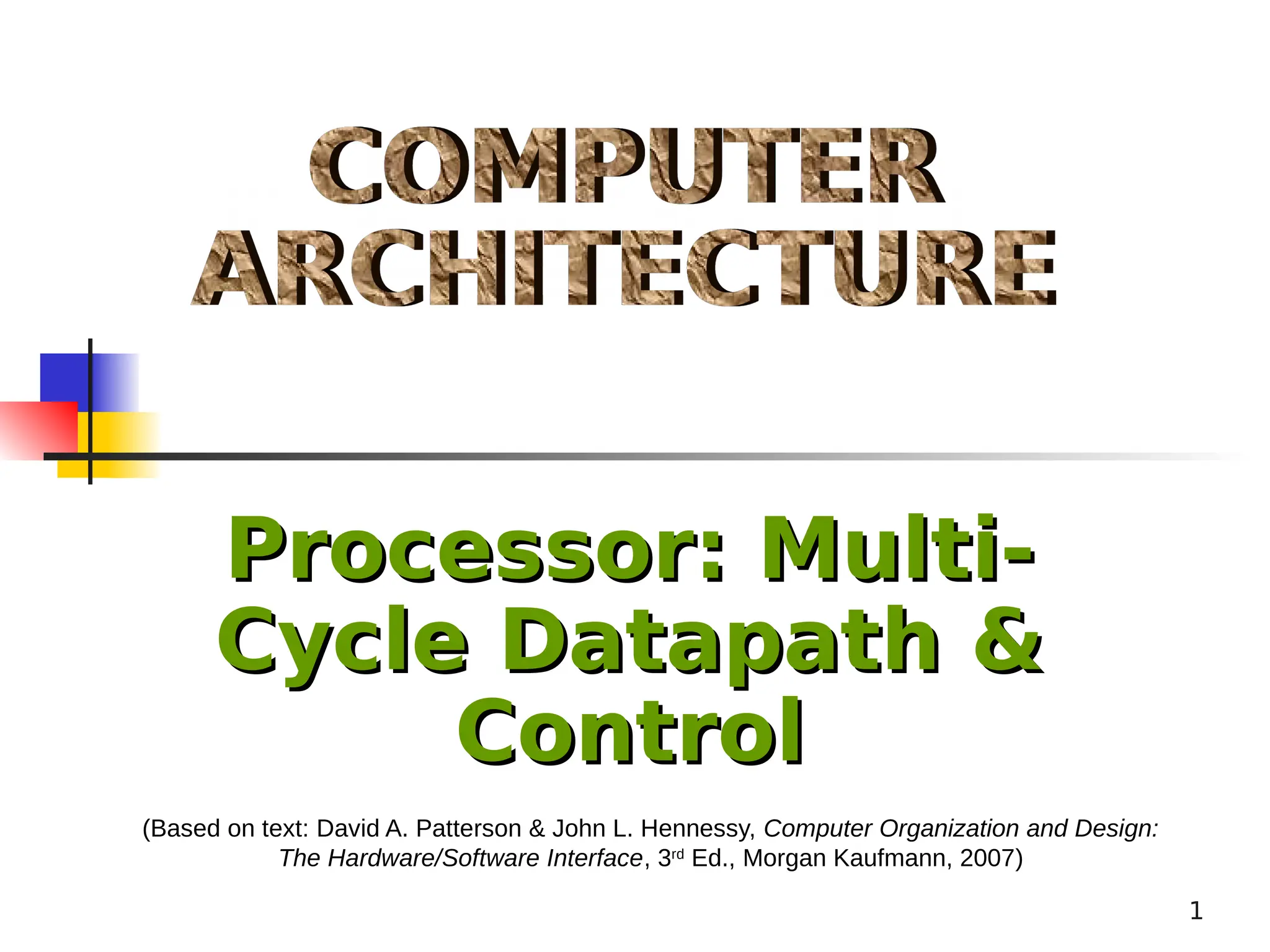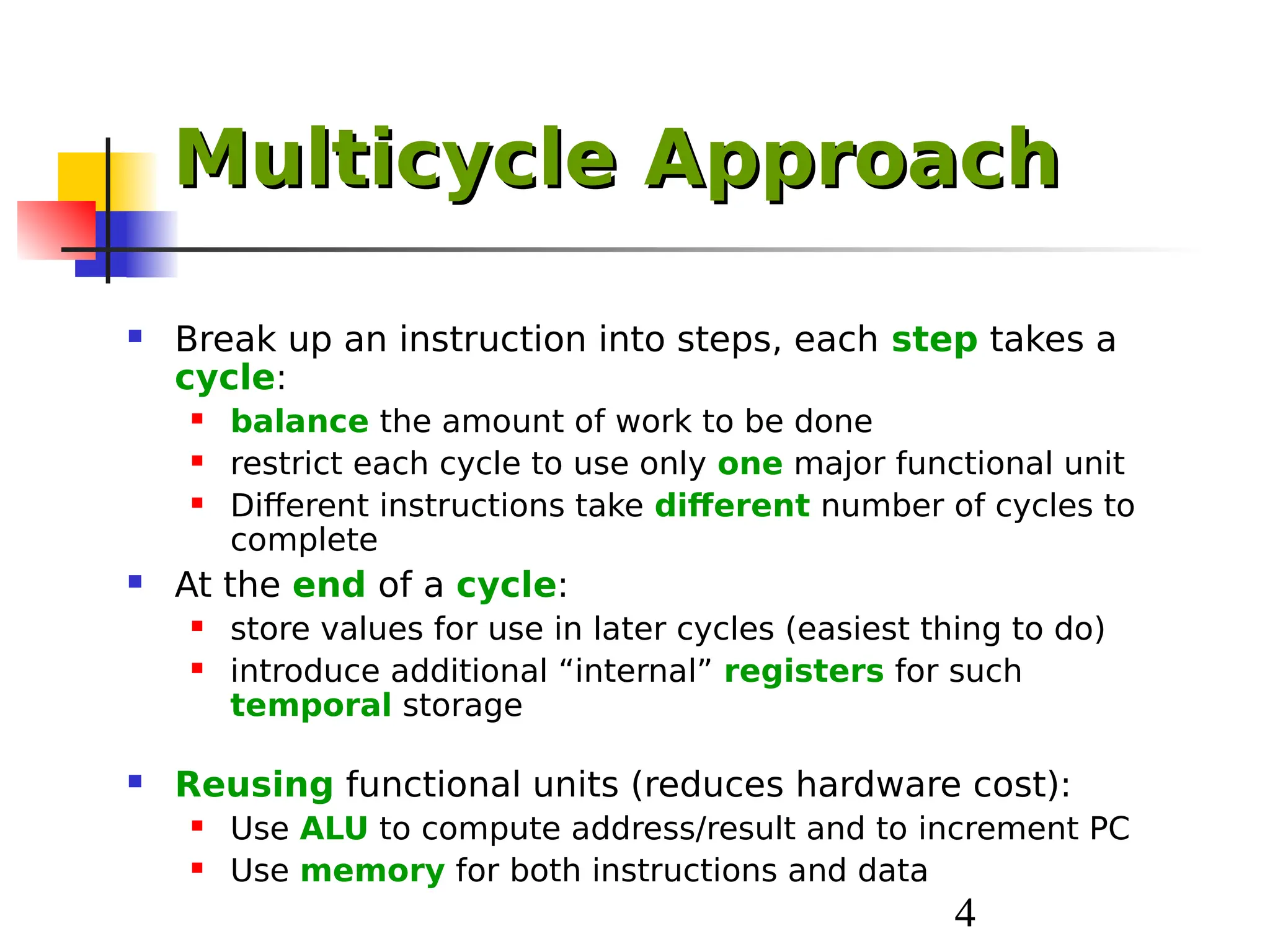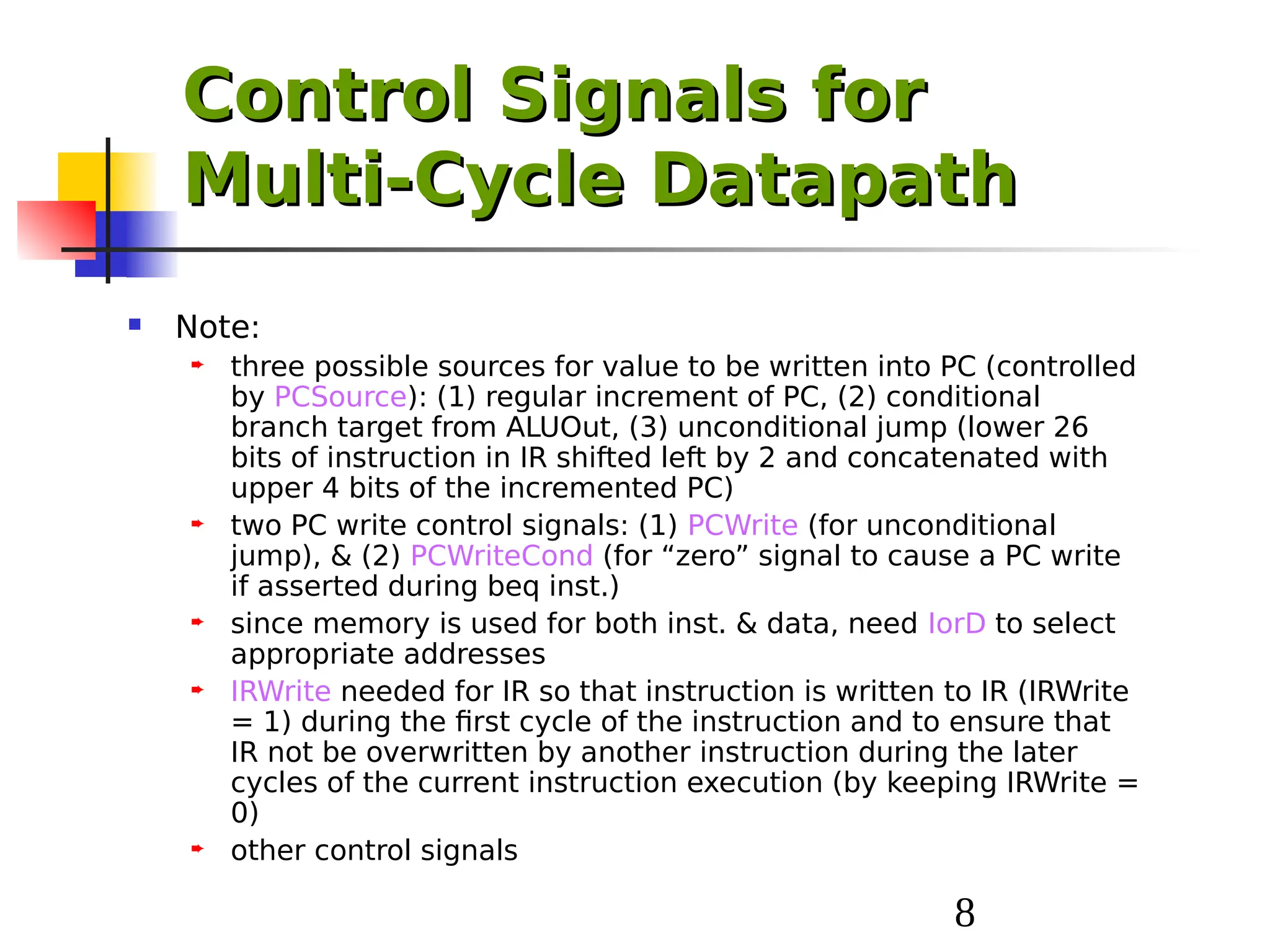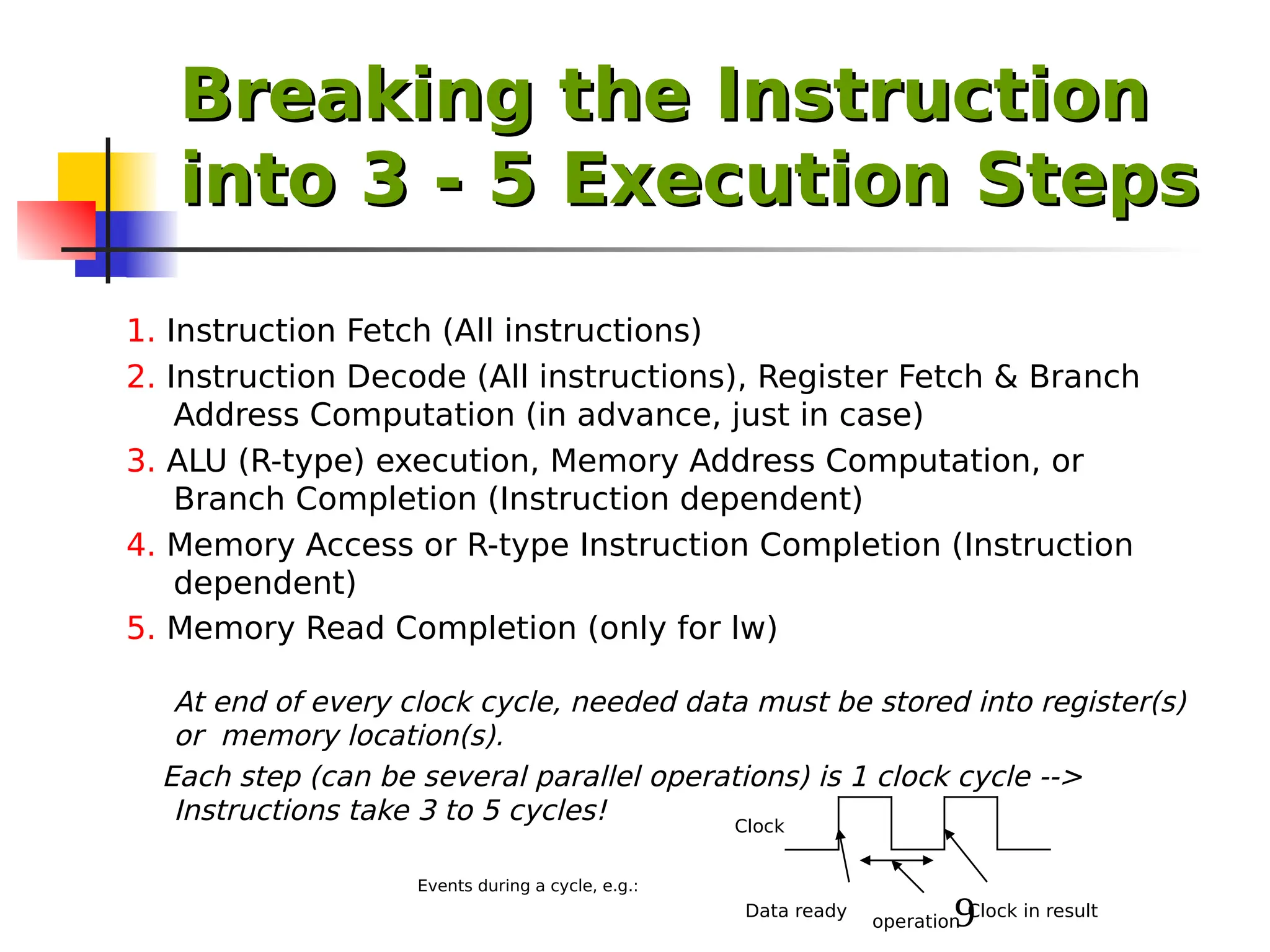The document describes the multi-cycle datapath and control approach for implementing a processor. It explains how instructions can be broken down into multiple execution steps that are each completed within a single clock cycle, allowing for simpler hardware at the cost of increased execution time per instruction. Additional registers are used to store intermediate results between cycles, and multiplexers allow functional units like the ALU and memory to be reused across cycles for different purposes. Control signals coordinate the movement of data between registers and functional units across each step of the multi-cycle implementation.




![5
Additional “internal registers”:
Instruction register (IR) -- to hold current instruction
Memory data register (MDR) -- to hold data read from memory
A register (A) & B register (B) -- to hold register operand values from register files
ALUOut register (ALUOut) -- to hold output of ALU, also serves as memory address
register (MAR)
All registers except IR hold data only between a pair of adjacent cycles and thus do
not need write control signals; IR holds instructions till end of instruction, hence
needs a write control signal
Multi-Cycle Datapath:
Multi-Cycle Datapath:
Additional Registers
Additional Registers
Shift
left 2
PC
Memory
Data
Write
data
M
u
x
0
1
Registers
Write
register
Write
data
Read
data 1
Read
data 2
Read
register 1
Read
register 2
M
u
x
0
1
M
u
x
0
1
4
Instruction
[15– 0]
Sign
extend
32
16
Instruction
[25– 21]
Instruction
[20– 16]
Instruction
[15– 0]
Instruction
register
1 M
u
x
0
3
2
M
u
x
ALU
result
ALU
Zero
Memory
data
register
Instruction
[15– 11]
A
B
ALUOut
0
1
Address
Inst /
Note: we ignore jump inst here](https://image.slidesharecdn.com/multi-cycle-240401184648-956ad261/75/multi-cycle-in-microprocessor-8086-sy-B-tech-5-2048.jpg)
![6
Additional multiplexors:
Mux for first ALU input -- to select A or PC (since we use ALU for both
address/result computation & PC increment)
Bigger mux for second ALU input -- due to two additional inputs: 4 (for normal PC
increment) and the sign-extended & shifted offset field (in branch address
computation)
Mux for memory address input -- to select instruction address or data address
Multicycle Datapath:
Multicycle Datapath:
Additional Multiplexors
Additional Multiplexors
Shift
left 2
PC
Memory
Data
Write
data
M
u
x
0
1
Registers
Write
register
Write
data
Read
data 1
Read
data 2
Read
register 1
Read
register 2
M
u
x
0
1
M
u
x
0
1
4
Instruction
[15– 0]
Sign
extend
32
16
Instruction
[25– 21]
Instruction
[20– 16]
Instruction
[15– 0]
Instruction
register
1 M
u
x
0
3
2
M
u
x
ALU
result
ALU
Zero
Memory
data
register
Instruction
[15– 11]
A
B
ALUOut
0
1
Address
Inst /
Note: we ignore jump inst here](https://image.slidesharecdn.com/multi-cycle-240401184648-956ad261/75/multi-cycle-in-microprocessor-8086-sy-B-tech-6-2048.jpg)



![10
Use PC to get instruction (from memory) and put it in the
Instruction Register
Increment of the PC by 4 and put the result back in the PC
Can be described succinctly using RTL "Register-Transfer
Language"
IR <= Memory[PC];
PC <= PC + 4;
Which control signals need to be asserted?
IorD = 0, MemRead = 1, IRWrite = 1
ALUSrcA = 0, ALUSrcB = 01, ALUOp = 00, PCWrite = 1, PCSource = 00
Why can instruction read & PC update be in the same step? Look at state element
timing
What is the advantage of updating the PC now?
Step 1: Instruction
Step 1: Instruction
Fetch
Fetch](https://image.slidesharecdn.com/multi-cycle-240401184648-956ad261/75/multi-cycle-in-microprocessor-8086-sy-B-tech-10-2048.jpg)
![11
In this step, we decode the instruction in IR (the opcode enters
control unit in order to generate control signals). In parallel,
we can
Read registers rs and rt, just in case we need them
Compute the branch address, just in case the instruction is a
branch beq
RTL:
A <= Reg[IR[25:21]];
B <= Reg[IR[20:16]];
ALUOut <= PC + (sign-extend(IR[15:0]) << 2);
Control signals:
ALUSrcA = 0, ALUSrcB = 11, ALUOp = 00 (add)
Note: no explicit control signals needed to write A, B, & ALUOut.
They are written by clock transitions automatically at end of step
Step 2: Instruction Decode,
Step 2: Instruction Decode,
Reg. Fetch, & Branch Addr.
Reg. Fetch, & Branch Addr.
Comp.
Comp.](https://image.slidesharecdn.com/multi-cycle-240401184648-956ad261/75/multi-cycle-in-microprocessor-8086-sy-B-tech-11-2048.jpg)
![12
One of four functions, based on instruction type:
Memory address computation (for lw, sw):
ALUOut <= A + sign-extend(IR[15:0]);
Control signals: ALUSrcA = 1, ALUSrcB = 10, ALUOp = 00
ALU (R-type):
ALUOut <= A op B;
Control signals: ALUSrcA = 1, ALUSrcB = 00, ALUOp = 10
Conditional branch:
if (A==B) PC <= ALUOut;
Control signals: ALUSrcA = 1, ALUSrcB = 00, ALUOp = 01 (Sub),
PCSource = 01, PCWriteCond = 1 (to enable zero to write PC if 1)
What is the content of ALUOut during this step? Immediately after this step?
Jump:
PC <= PC[31:28] || (IR[25:0]<<2);
Control signals: PCSource = 10, PCWrite = 1
Note: Conditional branch & jump instructions completed at this step!
Step 3: Instruction
Step 3: Instruction
Dependent Operation
Dependent Operation](https://image.slidesharecdn.com/multi-cycle-240401184648-956ad261/75/multi-cycle-in-microprocessor-8086-sy-B-tech-12-2048.jpg)
![13
For lw or sw instructions (access memory):
MDR <= Memory[ALUOut];
or
Memory[ALUOut] <= B;
Control signals (for lw): IorD = 1 (to select ALUOut as address),
MemRead = 1, note that no write signal needed for writing to MDR, it is written
by clock transition automatically at end of step
Control signals (for sw): IorD = 1 (to select ALUOut as address),
MemWrite = 1
For ALU (R-type) instructions (write result to register):
Reg[IR[15:11]] <= ALUOut;
Control signals: RegDst = 1 (to select register address), MemtoReg = 0,
RegWrite = 1
Step 4: Memory Access or
Step 4: Memory Access or
ALU
ALU
(R-type) Instruction
(R-type) Instruction
Completion
Completion](https://image.slidesharecdn.com/multi-cycle-240401184648-956ad261/75/multi-cycle-in-microprocessor-8086-sy-B-tech-13-2048.jpg)
![14
For lw instruction only (write data from MDR to register):
Reg[IR[20:16]]<= MDR;
Control signals: RegDst = 0 (to select register address),
MemtoReg = 1, RegWrite = 1
Note: lw instruction completed at this step!
Step 5: Memory Read
Step 5: Memory Read
Completion
Completion](https://image.slidesharecdn.com/multi-cycle-240401184648-956ad261/75/multi-cycle-in-microprocessor-8086-sy-B-tech-14-2048.jpg)
![15
Summary of Execution
Summary of Execution
Steps
Steps
Step name
Action for R-type
instructions
Action for memory-reference
instructions
Action for
branches
Action for
jumps
Instruction fetch IR <= Memory[PC]
PC <= PC + 4
Instruction A <= Reg [IR[25:21]]
decode/register fetch B <= Reg [IR[20:16]]
/branch addr comp ALUOut <= PC + (sign-extend (IR[15:0]) << 2)
Execution, address ALUOut <= A op B ALUOut <= A + sign-extend if (A ==B) then PC <= PC [31:28]
computation, branch/ (IR[15:0]) PC <= ALUOut II(IR[25:0]<<2)
jump completion
Memory access or R-type Reg [IR[15:11]] <= Load: MDR <= Memory[ALUOut]
completion ALUOut or
Store: Memory[ALUOut] <= B
Memory read completion Load: Reg[IR[20:16]] <= MDR
Some instructions take shorter number of cycles, therefore next instructions can start earlier.
Hence, compare to single-cycle implementation where all instructions take same amount of time, multi-cycle
implementation is faster!
Multi-cycle implementation also reduces hardware cost (reduces adders & memory, increases number of](https://image.slidesharecdn.com/multi-cycle-240401184648-956ad261/75/multi-cycle-in-microprocessor-8086-sy-B-tech-15-2048.jpg)
